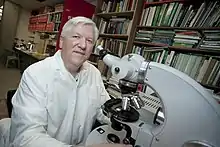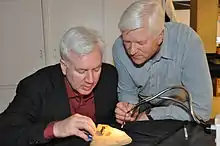Rolf Mathewes
Rolf Walter Mathewes is a Canadian paleoecologist. He is a full professor and former associate dean of science at Simon Fraser University.
Rolf Mathewes | |
|---|---|
 Mathewes in 2010 | |
| Born | Surrey, British Columbia, Canada |
| Spouse(s) | Donna |
| Children | 2 |
| Academic background | |
| Education | B.S.c, 1969, Simon Fraser University PhD., Botany, 1973, University of British Columbia Postdoc, Cambridge University |
| Thesis | Paleoecology of postglacial sediments in the Fraser Lowland region of British Columbia (1973) |
| Academic work | |
| Institutions | Simon Fraser University |
Education
Mathewes attended Princess Margaret Secondary School[1] and was taught biology by Rene Savenye.[2] He earned his Bachelor of Science from Simon Fraser University (SFU) before achieving his PhD at the University of British Columbia.[3]
Career

Mathewes joined the Faculty of Biological Sciences at SFU in 1975.[4] He was promoted to Associate Professor in 1982 before becoming a full professor in 1987. A few years later, he served a three year term as Associate Chair of Biology[3] and was elected president of the American Association of Stratigraphic Palynolygists.[5] On August 1, 2000, he was appointed Associate Dean of Science at SFU.[6] In 2001, he co-published "Late Quaternary paleoenvironments of Northwestern North America: implications for inland versus coastal migration routes."
In 2004, Mathewes was repeatedly contacted by the Vancouver Police Department (VPD) to analyze evidence at the crime scene.[7] A few years later, in 2007, he was part of a group of researchers working at SFU's Centre for Forensic Studies.[8]
In 2011, Mathewes was honoured with SFUs Outstanding Alumni Award.[9] A few years later, while collaborating with Bruce Archibald and researchers from Naturmuseum Senckenberg, he discovered three extinct fossil species of big-headed flies. Only one of the fossils was well-enough preserved to be named as a new species.[10] In 2019, Mathewes was part of an archeology team that discovered proof of life in Haida Gwaii that dated back 13,000 years,which indicated that the land was occupied approximately 2,200 years prior to the previous estimates of 10,000 to 10,800 years ago.[11][12]
References
- "Alumni Watching". sfu.ca. November 2005. Retrieved November 3, 2019.
- Meadahl, Marianne (September 19, 2002). "Ancient fossil cherished". sfu.ca. Retrieved November 3, 2019.
- "Alumni profiles: Rolf Mathewes". sfu.ca. Retrieved November 3, 2019.
- "Rare event celebrated". sfu.ca. May 30, 2002. Retrieved November 3, 2019.
- "Spotlight". sfu.ca. September 18, 1997. Retrieved November 3, 2019.
- "Board Briefs". sfu.ca. September 7, 2000. Retrieved November 3, 2019.
- Thorbes, Carol (January 22, 2004). "Criminals Beware". sfu.ca. Retrieved November 3, 2019.
- "High-security crime research centre to open". sfu.ca. January 25, 2007. Retrieved November 3, 2019.
- "SFU ALUMNI UPDATE E-NEWSLETTER: JANUARY 2012". sfu.ca. January 2012. Retrieved November 3, 2019.
- "Fossil flies track major ecological revolution". sfu.ca. January 10, 2014. Retrieved November 3, 2019.
- "Archaeologist make historic find in Haida Gwaii". aptnnews.ca. September 24, 2019. Retrieved November 3, 2019.
- "Archaeological breakthrough on Haida Gwaii". bclocalnews.com. September 29, 2019. Retrieved November 3, 2019.
